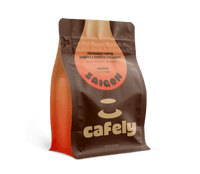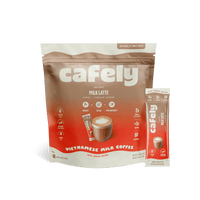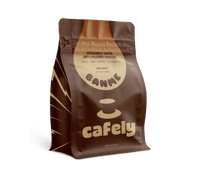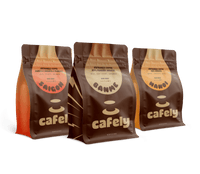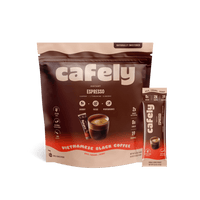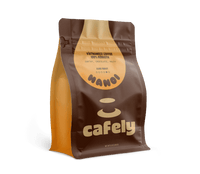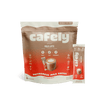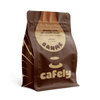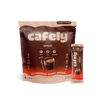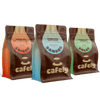If you’ve chosen a vegan lifestyle, you may be wondering if there’s a way for you to enjoy a cup of authentic Vietnamese coffee.
This popular drink is traditionally made with a bold cup of robusta coffee and sweetened condensed milk — something that’s off-limits for vegans.
But don't worry; we’ll explain all you need to know about Vietnamese coffee and how to make it vegan, including tips for brewing it and how to get the best flavor.
Is Vietnamese Coffee Vegan?
Vietnamese iced coffee (Cà phê sữa đá) combines the best robusta beans grown in Vietnam with a special brewing process using a phin filter. How it’s flavored can vary substantially — some preparation methods are vegan-friendly by default.
The most common sweetener for Vietnamese coffee is condensed milk, but non-dairy options are also popular — such as coconut cream, almond milk, and soy milk.
Vietnamese coffee can be served hot or cold (poured over ice).
Here’s a quick recipe to make delicious vegan-friendly Vietnamese coffee with 3 ingredients:
The Recipe: Vegan Vietnamese Coffee
This recipe uses full-fat coconut milk and a source of sugar to thicken the coconut cream and help balance the strong, bold flavors of Vietnamese coffee. White sugar, cane sugar, honey, and maple syrup all work.
Before you start, here’s what you’ll need to make the best vegan Vietnamese coffee.
Tools & Ingredients

- A phin filter — This traditional coffeemaker sits at the heart of Vietnamese coffee culture. This cheap little device crafts a silky smooth yet strong cup of coffee in minutes.
- High-quality coffee grounds — We suggest Cafely’s SaiGon OG, a bold, dark, traditional Vietnamese roast. A quality cup of coffee starts with quality beans!
- Full-fat coconut milk — A creamy, rich substitute that mimics the texture of traditional condensed milk.
- Sugar (Cane sugar, honey, or maple syrup also works) — use ⅓ cup for one 14-ounce can of coconut milk.
- Saucepan— For making the condensed milk.
- Hot water — To brew the coffee.
- Ice — This is optional; add if you want iced Vietnamese coffee.
Step 1: Prepare the Vegan Condensed Milk

Sweetened condensed milk is a signature ingredient in traditional Vietnamese coffee. This recipe creates a delicious vegan-friendly alternative. We recommend cooking this in large batches and storing it in the fridge to use whenever you make your morning coffee.
How to make vegan sweetened condensed milk:
- Add one 14-ounce can of full-fat coconut milk and ⅓ cup of maple syrup or honey into a saucepan.
- Heat over medium heat, stirring often, until simmering.
- Turn the heat down to low and continue simmering for 45 minutes or until it's thick.
- Stir often to keep the mixture from scalding.
- Remove from heat and allow to cool.
- Store it in a jar in the refrigerator.
Step 2: Brew the Coffee

We recommend brewing your coffee with a phin filter — but other brewing methods will work, too (see below).
For 4 oz phin coffee, start by filling the brew chamber with 2 tablespoons (14 g) of medium-fine ground coffee and place it over your cup with the vegan milk.
Next, gently press the gravity filter on top of the grounds to flatten it out.
Pour a small amount of hot water evenly over your grinds and wait 45 seconds — this is known as “blooming” the coffee.
Fill the phin chamber with hot water to cover the filter press and place the lid on top to hold in the heat. Allow 5–7 minutes for the coffee to finish brewing.
Step 3: Serve & Enjoy!

For hot coffee, simply mix your coffee with 1–3 tablespoons (15–45 mL) of your vegan milk alternative.
For iced coffee, pour your brew into a glass cup filled with ice. Give your coffee a moment to cool down before adding the vegan condensed milk overtop. You should get a beautifully distinct separation of layers. Stir before drinking.
Other Methods of Making Vegan Vietnamese Coffee

This vegan Vietnamese coffee recipe follows the traditional method of making Vietnamese coffee. If you don’t have a phin filter, here are other ways to make it.
1. French Press
This is the closest method to using a phin, and while it doesn’t create the exact results, it’s pretty close. You’ll still use Vietnamese coffee beans — we suggest the DaLat beans if you want something lighter — but choose a medium-coarse grind.
Full Guide: How to Brew Delicious Coffee With a French Press
2. Espresso Machine
Espresso is very strong and similar to Vietnamese coffee, but use a fine grind with this method. Black espresso coffee won’t be the same as Vietnamese coffee, but with the addition of the vegan condensed milk outlined in the recipe above, you can get a very similar flavor.
Full Guide: How to Brew Coffee With an Espresso Machine
3. Moka pot
The classic Italian moka makes an espresso-type coffee on the stovetop. Hot water is driven by vapor pressure through ground coffee. These pots are rising in popularity among espresso lovers — they're much cheaper than an espresso machine — and will give you a flavor quite similar to traditional Vietnamese coffee.
Full Guide: How to Brew Coffee With a Moka Pot
Tips for Making the Best Vegan Vietnamese Coffee

You could run into some bumps in the road when you’re making vegan Vietnamese coffee.
Here are some things you can do to make sure your coffee turns out:
1. Take Time to Make the Milk
Vegan Vietnamese coffee has an extra step: preparing the vegan sweetened condensed milk, which takes a while. However, the recipe we provided makes enough to last a while. The homemade "milk" will keep in the fridge, allowing you to make vegan Vietnamese coffee quickly.
2. Buy a Phin Filter
A traditional Vietnamese phin filter is the key to authentic Vietnamese coffee. The best part is these devices are cheap to buy, durable, and require no disposable filters.
3. Use the Right Beans
Vietnamese coffee is traditionally made with robusta beans (such as our HaNoi blend), giving the coffee a deep, bold flavor. Since it’s typically brewed black or with plant-based condensed milk alternatives, it can easily be enjoyed as one of the best vegan coffee option without compromising on taste.
You can use an arabica like our DaLat Coffee (100% Arabica) or a robusta/arabica blend like our DaNang.
For a truly authentic flavor, we recommend a traditional butter-roast Vietnamese coffee bean, such as our SaiGon OG.
Note: All Cafely’s pre-ground coffees are prepared using a medium-fine grind — perfect for brewing with the phin filter.
4. Bloom Your Coffee
This is simply pouring about an ounce of hot water onto the coffee grounds before adding the rest. This allows carbon dioxide to escape and releases aromatic oils, giving the cup of coffee a better flavor.
5. Be Patient While it Brews
You have to wait 5-7 minutes while the water passes through the filter into the cup, but don't rush the process — the coffee won't taste right if you try and force it.
The Benefits of Vegan Vietnamese Coffee
There’s more to Vietnamese coffee than just the robust flavor.
Studies show you could also enjoy these possible benefits when you drink vegan Vietnamese coffee:
- Antioxidants — Vietnamese coffee is most often made with robusta beans, which are higher in antioxidants than arabica [1]. Antioxidants are believed to neutralize harmful free radicals in the body.
- Cognitive function — It’s believed that caffeine boosts cognitive function by increasing alertness and concentration and temporarily alleviating fatigue [2].
- Physical benefits — it’s also thought caffeine can increase stamina and endurance in physical activity [3].
- Mood enhancer — There’s nothing like a good cup of Vietnamese coffee to boost your mood [4].
- Good for the environment — Vegan Vietnamese coffee does not have any animal products, and the phin filter doesn’t use a paper filter, which is a bonus for the environment.
There are additional benefits and risks when drinking caffeine regularly.
FAQs: Vegan Vietnamese Coffee

Still have questions? We’ll try to answer them next.
1. Does Vietnamese coffee have dairy?
Traditional Vietnamese coffee recipes call for dairy in the form of condensed milk — however, dairy free options have been around for a long time too. Ingredients like coconut milk, soy milk, or simple sugar or honey have long been used to sweeten Vietnamese coffees.
Numerous proprietary non-dairy creamer formulas are available these days, too.
2. Is Vietnamese coffee bad for you?
There are some possible benefits to drinking Vietnamese coffee as we mentioned above. However, vegan and traditional Vietnamese coffee recipes contain simple sugar, so you may want to watch your intake if you’re concerned about it. The good news is that the vegan version can have less sugar than the traditional because you’re making it yourself. Simply add less sugar if you want to limit your intake.
3. Is vegan Vietnamese coffee fattening?
Vietnamese coffee itself isn’t fattening, but the addition of vegan condensed milk does add calories. About 3.5 ounces (100 grams) of coconut milk contains 230 calories and 24 grams of fat, and the sugar can contain about 50 calories. If you are counting calories, you may want to limit the number of cups of vegan Vietnamese coffee you enjoy each day.
4. Do I have to use a phin filter to make vegan Vietnamese coffee?
No, a phin filter makes the best-tasting Vietnamese coffee, but you can also use a French press, espresso machine, AeroPress, or a moka pot if you don’t have this device.
5. Does all Vietnamese coffee have condensed milk?
The traditional method of making Vietnamese coffee — hot or iced — is with condensed milk, robusta Vietnamese coffee beans, and a phin filter. There are other variations, such as strong Vietnamese egg coffee or Vietnamese coconut milk coffee. Vietnamese black coffee and coffee with sugar are common forms that don’t contain any milk.
References
- Hasbullah, U. H. A. A. (2021, February). Antioxidant activity and total phenolic compounds of arabica and robusta coffee at different roasting levels. In Journal of Physics: Conference Series (Vol. 1764, No. 1, p. 012033). IOP Publishing.
- Renda, G., & De Caterina, R. (2020). Caffeine. In Principles of nutrigenetics and nutrigenomics (pp. 335-340). Academic Press.
- Graham, T. E. (2001). Caffeine and exercise. Sports medicine, 31(11), 785-807.
- Alasmari, F. (2020). Caffeine induces neurobehavioral effects through modulating neurotransmitters. Saudi Pharmaceutical Journal, 28(4), 445-451.
